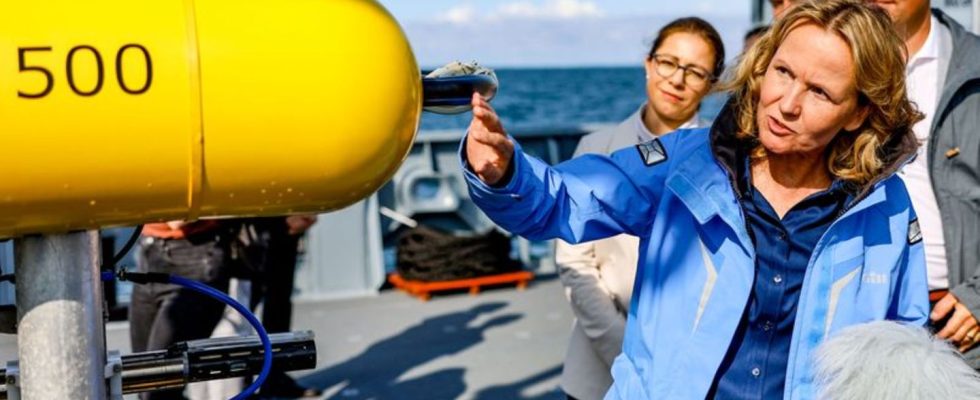Environment
Ammunition in the sea: Creeping danger in the depths
“Around 1.6 million tons of rusting old ammunition in the North Sea and Baltic Sea represent an increasing danger to people and the environment,” says Federal Environment Minister Steffi Lemke. photo
© Axel Heimken/dpa
Huge amounts of old World War II ammunition are rusting away in the North and Baltic Seas. Salvage operations are scheduled to begin in the Bay of Lübeck in the spring.
Some of them have been lying in heaps on the bottom of the North and North for decades Baltic Sea. Explosive devices, torpedoes and ammunition from the world wars rot there and release pollutants. Now Germany wants to start salvaging them.
A pilot project will start in the Baltic Sea in spring. “The Germans love the sea and those who love the sea get the military legacy out of there,” says Schleswig-Holstein’s Environment Minister Tobias Goldschmidt (Greens).
With the six-month project, experts want to collect information about the condition of the ammunition and use this to develop a floating disposal facility. The first 50 tons are to be taken from the Bay of Lübeck at two points and the Bay of Mecklenburg at one point. This ammunition is disposed of in an incineration plant in Munster, Lower Saxony. The federal government has provided 100 million euros to start the rescue effort.
Goldschmidt: 1.6 million tons of conventional ammunition
“We assume that 1.6 million tons of conventional ammunition were dumped in the seas after the war,” says Goldschmidt. While in the North Sea this is partly covered by seabed due to sediment movements during ebb and flow and therefore hardly rusts, the problem in the Baltic Sea is more pressing. “The ammunition there is usually lying free on the seabed and therefore rusts more quickly,” says Goldschmidt. “That’s why we’re starting in the Baltic Sea.” Even under good conditions, the recovery would take more than 30 years. “This could create an economic sector with global significance in Germany because there is a problem with old ammunition around the world.” Germany has a pioneering role.
Federal Environment Minister Steffi Lemke (Greens) argues similarly. The aim is to safely recover old ammunition and dispose of it in an environmentally friendly manner. “And on an industrial scale.” This is unique in the world so far. “I am pleased that we are now taking big steps forward and will begin developing and building a mobile floating waste disposal facility in 2024/25.”
Her Kiel counterpart Goldschmidt expects costs of around 100 million euros annually to systematically remove mines, torpedoes and ammunition from German waters. Schleswig-Holstein is prepared to contribute financially. Non-coastal countries should also do this, because World War II ammunition is not just a North German problem.
Permanent salvage planned from 2026
“Permanent salvage work by the federal and state governments should begin in 2026,” says the federal government’s maritime commissioner, Sebastian Unger. Given the volume, it is a generational task. It is uncertain whether all warfare agents can ever be recovered from the seas. Lemke has doubts. A lot of things were probably too rusty, she said during a visit to the Bay of Kiel in late summer. “There is a massive problem lurking at the bottom of the sea,” she says now. “Around 1.6 million tons of rusting old ammunition in the North Sea and Baltic Sea represent an increasing danger to people and the environment.”
The problem has been known for a long time. After the end of the war, most of the ammunition was deliberately dumped in the seas. “The bulk of the munitions contamination lies in around 70 areas in both seas,” says department head Alexander Bach from the Environment Ministry in Kiel. After the end of the war, the ports recorded exactly what was loaded on board the ships for trips to the dumping areas. Most of the ammunition in the Baltic Sea is in the so-called Kolberg Heath off Kiel and in the Bay of Lübeck. “50,000 tons are estimated in the Bay of Lübeck alone.”
Ammunition and basic mines
On the bottom of the Baltic Sea there are crates of torpedoes, artillery, anti-aircraft and small arms ammunition, grenades and also larger maritime ordnance such as anchor ropes and ground mines. The large amount of explosives is TNT, says Goldschmidt. There are studies on the food chain and carcinogenic substances have already been found in mussels. “Because the substances are penetrating the food chain, it is really high time that the ammunition was recovered with a lot of effort and money.”
While most of the ammunition is suspected to be in known dumping areas off the Schleswig-Holstein coast, it is much more distributed in the neighboring country. “Mecklenburg-Western Pomerania actually doesn’t have a sinking area in that sense, but rather many training and shooting areas,” says department head Bach.
For Umerltminister Goldschmidt, the recovery of old ammunition also has an economic dimension. “The overall poor condition of the Baltic Sea is a threat to tourism.” If the sea doesn’t do well, the country’s image could be seriously damaged. “We also see that the pollution caused by the release of TNT is increasing.” According to science, neither the consumption of fish nor mussels is currently dangerous.
In its coalition agreement, the federal government agreed to launch an immediate program to tackle the recovery of ammunition and warfare agents from the North and Baltic Seas.

